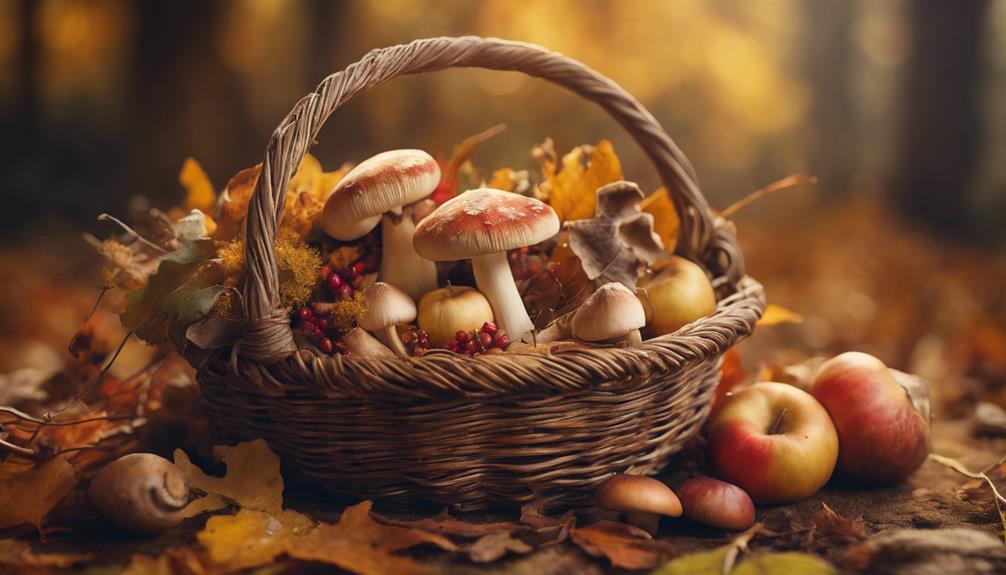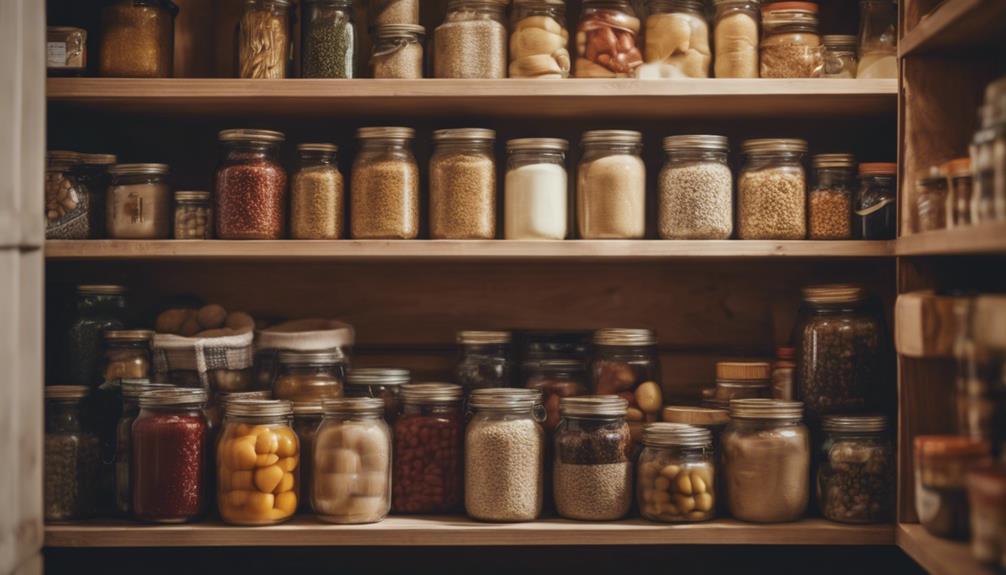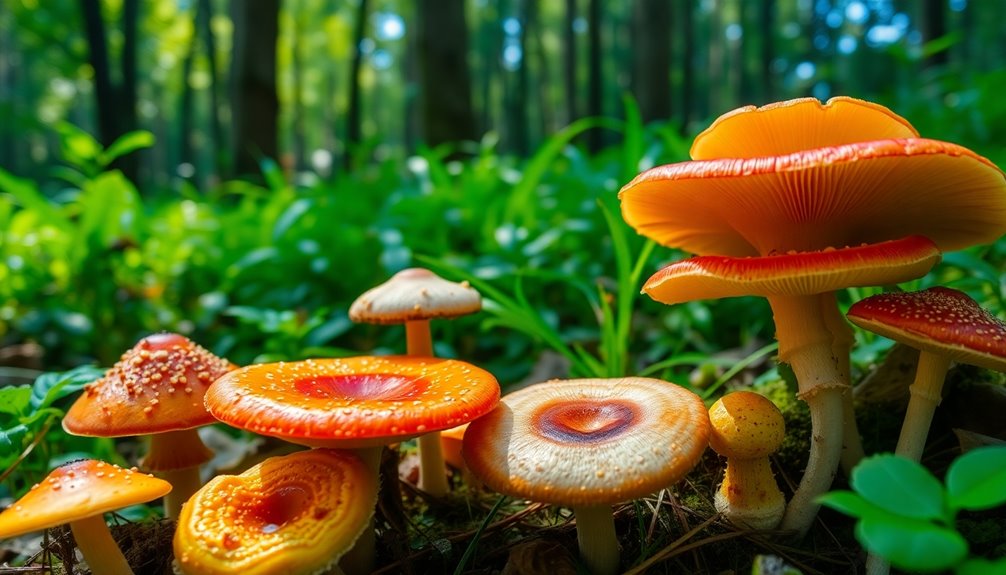As you explore the UK's autumn landscape, you'll find a wealth of wild edibles. Crunchy beech nuts, tangy crab apples, and flavorful mushrooms like bay boletes and Shaggy Ink Caps await discovery. Fruits like rose hips, sloes, and elderberries offer a rich source of vitamin C and antioxidants. To guarantee a safe and sustainable foraging experience, educate yourself on identification, preparation, and responsible harvesting practices. By doing so, you'll not only reap the benefits of autumn's bounty but also support local ecosystems and biodiversity. Dive deeper to uncover the secrets of October's foraging treasures.
Key Takeaways
- In October, forage for beech nuts, rose hips, and sloes, which are nutritious and versatile options in the UK.
- Abundant fruits like crab apples, blackberries, and elderberries offer a rich source of vitamin C and antioxidants.
- Mushrooms like bay boletes, Shaggy Ink Caps, and Penny Buns are plentiful in October, providing a variety of options.
- Ensure sustainable foraging practices by taking only what you need, respecting the land, and researching UK foraging laws.
- October's abundance of wild foods provides a cost-effective way to source fresh produce, supporting local ecosystems and biodiversity.
Autumn's Bounty: What to Forage
As you venture out into the UK's autumn landscape in October, you'll find a plethora of wild edibles waiting to be discovered. This is an excellent time for foraging, as the late autumn season offers a variety of wild foods that are ripe for the picking.
Beech nuts, for instance, are a nutritious find, with a flavor similar to pine nuts, making them a great addition to various dishes.
Rose hips, rich in Vitamin C, are another treasure to uncover, commonly used in wines, jams, and syrups.
Sloes, an essential ingredient in traditional Sloe gin, are best picked after the first frost, when they're at their sweetest.
If you're a fan of mushrooms, October is a great time to forage for bay bolete, a tasty variety similar to Porcini, which can be found in abundance.
As you explore the UK's autumn landscape, remember to respect the land and only take what you need, ensuring a sustainable foraging experience for everyone.
Safety Reminders for Foragers

As you venture out to forage in October, remember that safety should always be your top priority.
You'll need to be vigilant about correctly identifying what you pick, since some plants, berries, and mushrooms have toxic lookalikes that can be harmful if ingested.
Be Aware of Lookalikes
You need to be vigilant when foraging, because some plants, berries, and mushrooms have toxic lookalikes that can be dangerous if consumed.
Take wild mushrooms, for instance – some species can be deadly if mistaken for edible ones.
Even Dandelion leaves, often considered safe, can be confused with lookalikes that are toxic.
To avoid mistakes, it's important to educate yourself through foraging courses or sustainable foraging practices.
Don't assume that what you find is safe just because it looks familiar.
Cross-reference multiple foraging books to confirm the identity of your finds, and never consume something you're not 100% sure about.
Remember, some foraged items might be safe when cooked but not when raw, so it's vital to understand the preparation methods as well.
When in doubt, it's always better to err on the side of caution and avoid consuming the item altogether.
Know What You Pick
What's the most critical step in foraging, especially in October when the UK's autumn bounty is at its peak? It's knowing what you pick. Mushrooms, berries, nuts, and fruits may be abundant, but many have toxic look-alikes that can pose serious health risks. Foraging in September, you might have already come across some early autumn treasures, but as the season progresses in October, even more diverse species emerge. Always consult a reliable guide or expert to ensure safe identification before consuming anything from the wild. As temperatures drop, it’s also crucial to remember that some plants and fungi change appearance as they mature, making identification trickier. Referring back to late summer foraging tips can help, but always adjust your knowledge to account for the seasonal transitions. When in doubt, it’s best to leave unfamiliar finds behind, as one mistaken identification can have serious consequences for your health.
When foraging in the UK, make sure you're 100% certain of what you're collecting. Some wild plants, berries, and mushrooms have toxic lookalikes, so accurate identification is vital. Don't assume you know what you've got – take the time to cross-reference multiple foraging books to confirm the safety of your finds.
Remember, some items may be safe to consume when cooked but not when raw, so understand the preparation methods too. If you're unsure about the safety of a plant or mushroom, don't take the risk – it's better to err on the side of caution. Start simple and only forage what you're absolutely sure of. Your health depends on it.
Edible Delights of the Forest

October's forest floor yields a bounty of treasures, with beechnuts, rosehips, and sloes ripe for the picking. As you venture into the woods, you'll discover a wealth of edible delights waiting to be foraged.
Beechnuts, rich in nutrients, can be enjoyed in salads or risottos after scraping off their outer brown skin. Rosehips, bursting with Vitamin C, are perfect for making wines, jellies, jams, and syrups. Sloes, famously used for making Sloe gin, are best picked after the first frost from September to December.
You might also stumble upon crab apples, a delicious addition to your autumn foraging haul. Late August marked the beginning of the autumn foraging season, and October is the perfect time to capitalize on the forest's bounty. Take a stroll through the forest and see what treasures you can uncover.
Don't forget to keep an eye out for Bay bolete and Shaggy Ink Cap mushrooms, adding variety to your finds. Happy foraging!
Fruits of the Season

As you venture out to forage in October, you'll discover a plethora of wild fruits waiting to be discovered. This season is particularly exciting, with wild berries abounding and crab apples ripening on the trees.
Get ready to explore the diverse range of flavors and culinary possibilities that October's fruits have to offer!
Wild Berries Abound
Explore the UK's autumn landscape to find a sweet and tangy treat that's bursting with vitamins and antioxidants. The wild berries that thrive in the UK's hedgerows and woodlands during the autumn months are a treasure trove of blackberries, elderberries, sloes, hawthorn berries, and wild damsons.
These late-season fruits are packed with vitamin C and antioxidants, making them a healthy addition to your foraged meals and recipes. You don't have to search extensively to find them – many urban areas have hidden gems of wild berries waiting to be discovered. Take a leisurely stroll through a local park or woodland, and you might chance upon a bounty of wild berries ripe for the picking.
While you gather these delicious fruits, take a moment to savor the beauty of the autumn season and the diverse flavors it offers. So, step outside and start foraging – your taste buds and body will be grateful!
Crab Apples Ripen
Stroll through the UK's autumn landscape, and you'll likely stumble upon crab apples, those small, tart fruits that ripen in October, waiting to be transformed into jams, jellies, and sauces.
These miniature apples can be found in hedgerows, parks, and gardens across the UK, depending on the weather conditions. Rich in pectin, crab apples are ideal for preserving and adding a tangy flavor to dishes. They come in various colors, ranging from red to yellow, and can be used in both sweet and savory recipes. They're a bit more tart than regular apples, but that's what makes them perfect for cooking.
Crab apples are often used in traditional British recipes and culinary creations, similar to how ripe nuts are used in baking. You can use them in a similar way, adding a burst of flavor to your autumn treats. With their versatility and abundance, crab apples are a forager's delight, waiting to be discovered and transformed into delicious creations.
Mushrooms to Discover

October's UK landscapes offer you a fascinating array of mushrooms to uncover, including the prized bay bolete and the beginner-friendly shaggy ink cap. As you venture out to forage, you'll discover a variety of species waiting to be discovered. Bay boletes, similar to porcini mushrooms, are a delicacy, while shaggy ink caps are abundant and easy to identify, making them perfect for novice foragers.
| Mushroom | Description |
|---|---|
| Bay Bolete | Delicious, similar to porcini mushrooms |
| Shaggy Ink Cap | Beginner-friendly, abundant in October |
| Penny Bun | A type of bolete, great for foraging |
Tips for Responsible Foraging

When foraging, remember to take only what you need, respecting the land and its resources. It's crucial to be mindful of the environment and the impact your actions may have. Worth noting is that foraging isn't just about gathering food; it's a way to connect with nature and learn about food sources.
Before you head out, research and understand foraging laws and restrictions in the UK to make sure you're foraging responsibly. Don't feel discouraged if you come back empty-handed; foraging is also about the experience and exploration.
The best thing about foraging is that it promotes sustainability by reconnecting us with nature and teaching us about local ecosystems. When foraging, be sure to leave some for others and for the ecosystem to thrive. If you notice that a particular area is still green and thriving, it's best to leave it be and explore other areas.
Join us in our commitment to responsible foraging, and together, we can guarantee that the natural world remains abundant for generations to come. By following these simple tips, you'll be well on your way to becoming a responsible forager.
Frequently Asked Questions
What Is Autumn Foraging?
As you explore the world of foraging, you'll discover that autumn foraging is all about venturing outdoors to gather wild, seasonal edibles like fruits, nuts, and mushrooms, connecting you with nature and its bounty.
Is It Illegal to Forage for Foliage in the Uk?
You're wondering if foraging for foliage is illegal in the UK. Luckily, it's not, as long as you have landowner permission on public land, but it's important to research local regulations and respect private property.
What Can You Eat in the Woods in the Uk?
As you wander through the UK woods, you'll discover a treasure trove of edible delights, like hazelnuts, wild mushrooms, and vitamin-rich fruits, waiting to be uncovered and savored in your autumnal culinary creations.
Conclusion
As you wrap up your autumn foraging adventures, remember that the forest is like a treasure chest – you never know what hidden gems you'll stumble upon.
Like the time I discovered a bounty of wild mushrooms hidden beneath a canopy of golden leaves.
With every foraging trip, you'll uncover the secrets of the season, and October's abundance will leave you feeling grateful for nature's generosity.
So, get out there, and start foraging – the forest is waiting to share its autumnal treasures with you!










